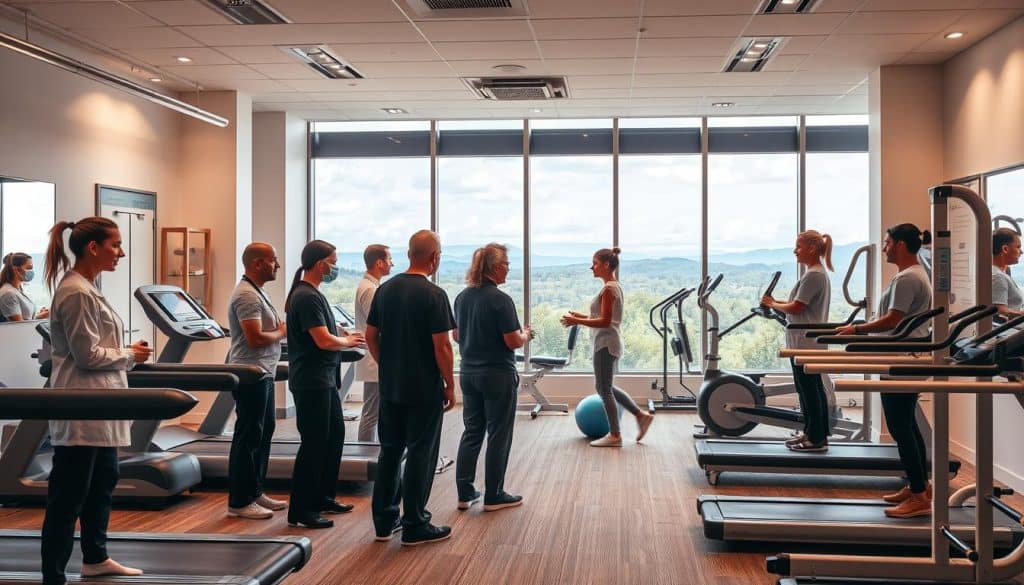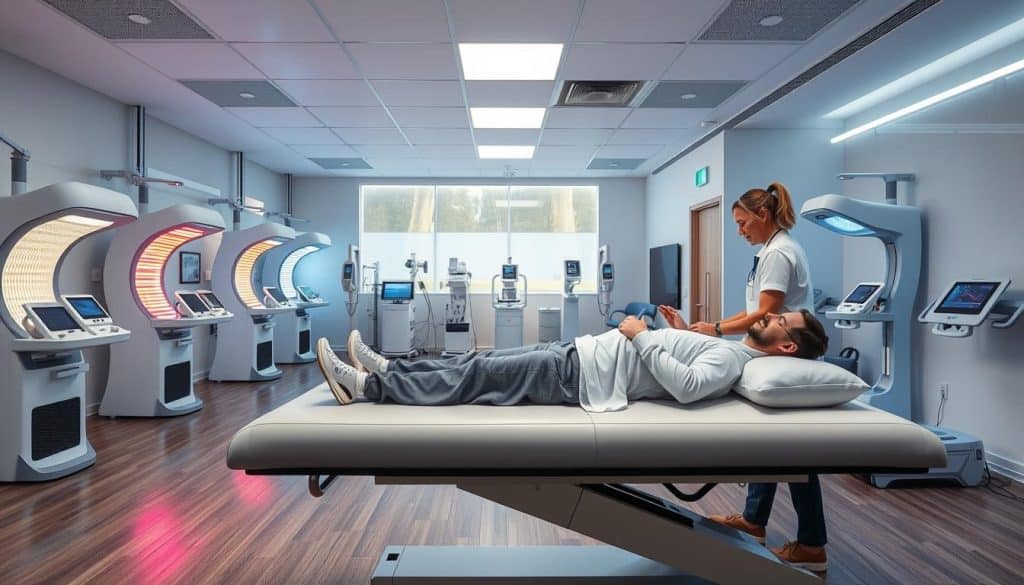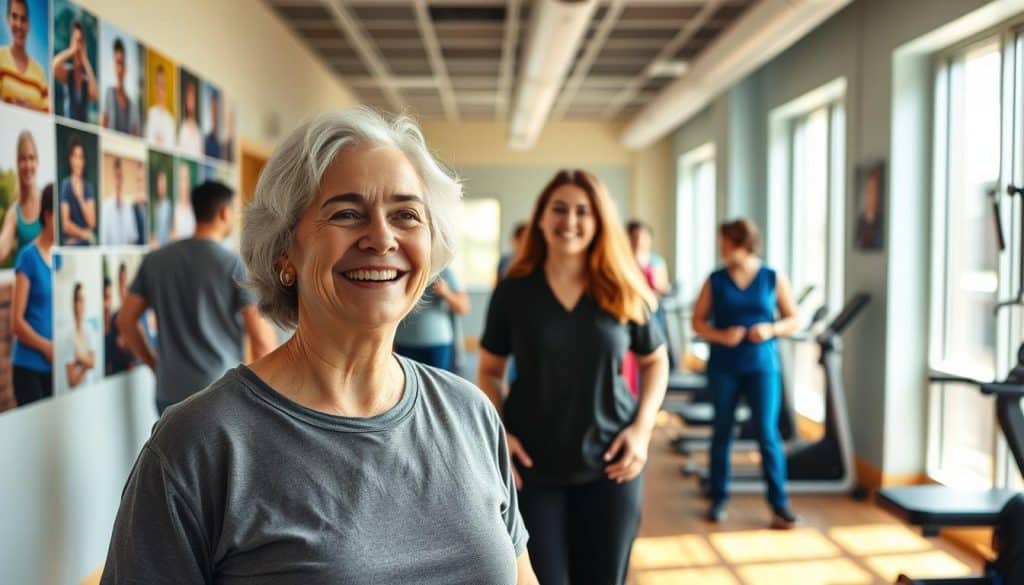At Riverside Sports Therapy, patients find trusted care tailored to their unique needs. Our team of highly qualified physicians combines advanced medicine with hands-on expertise to deliver results. Located in the heart of Calgary, AB, Canada, we prioritize accessibility for those seeking recovery and peak physical performance. Call us at (403) 283-7551 to start your journey today.
What sets our clinic apart? We focus on active patient involvement, ensuring every treatment plan aligns with individual goals. From sports injuries to chronic pain management, our medicine-based strategies blend cutting-edge techniques with compassionate support. This approach has built our reputation as leaders in personalized rehabilitation and athletic therapy.
Whether you’re an athlete or someone rebuilding strength, our specialists emphasize collaboration. By integrating the latest advancements in medicine, we create programs that adapt as you progress. Your recovery isn’t just our job—it’s our shared mission.
Key Takeaways
- Riverside Sports Therapy offers expert care through highly trained physicians.
- The clinic’s Calgary location ensures easy access for local residents.
- Personalized treatment plans merge innovative medicine with rehabilitation science.
- Active patient participation is central to achieving long-term success.
- Contact (403) 283-7551 to schedule a consultation or learn more.
Our Calgary Rehabilitation Specialists Services
Effective recovery requires more than generic solutions. Our clinic blends medicine rehabilitation principles with sports therapy to address injuries, chronic pain, and mobility challenges. Every program is designed to match your body’s needs, whether you’re healing from a recent injury or managing long-term discomfort.
Overview of Rehabilitation and Sports Medicine
We offer a full spectrum of services, from advanced diagnostics to targeted treatment plans. Techniques like therapeutic exercises, manual therapy, and ultrasound-guided interventions ensure precise care. Our team also specializes in sports-related recovery, helping athletes regain strength without compromising future performance.
| Service Category | Methods Used | Primary Benefits |
|---|---|---|
| Acute Injury Care | Manual Therapy, Electrodiagnostics | Reduces swelling, accelerates healing |
| Chronic Pain Management | Custom Exercise Plans, Injections | Improves mobility, minimizes discomfort |
| Sports Performance | Biomechanical Analysis, Active Rehab | Enhances endurance, prevents re-injury |
Key Benefits of Personalized Care
No two recovery journeys are identical. By creating tailored strategies, we address factors like lifestyle, activity levels, and medical history. This approach leads to faster results and lasting improvements. Patients also learn self-management techniques to maintain progress long after treatment ends.
Comprehensive Medicine and Rehabilitation Approach
Modern recovery demands strategies that bridge multiple disciplines. At our clinic, physical medicine rehabilitation forms the core of how we resolve complex musculoskeletal and neurological challenges. This approach ensures no aspect of a patient’s condition is overlooked.

Interdisciplinary Treatment Methods
Our team combines diagnostic tools like EMG assessments with therapies such as interventional pain management. This blend allows precise identification of issues while delivering targeted relief. For example, nerve dysfunction detected through electrodiagnostics can be immediately addressed with customized exercise plans.
| Treatment Method | Primary Application | Key Outcomes |
|---|---|---|
| Physical Therapy | Restoring mobility post-injury | Improved joint flexibility, reduced stiffness |
| Pain Management Injections | Chronic inflammation or nerve pain | Localized relief, faster healing |
| Neurological Re-education | Stroke or spinal cord recovery | Enhanced motor control, balance |
Collaboration between physiatrists, therapists, and patients is non-negotiable. Weekly case reviews ensure treatment plans evolve as progress occurs. This synergy between disciplines accelerates functional recovery while preventing setbacks.
Physical medicine rehabilitation thrives when therapies complement each other. Manual adjustments might prepare muscles for strength training, while hydrotherapy reduces strain on healing tissues. Every method has a purpose—and together, they rebuild lives.
Personalized Care and Tailored Treatment Plans
True healing begins when care adapts to the individual, not the other way around. Our clinic rejects cookie-cutter approaches, focusing instead on aligning every strategy with your body’s unique needs and aspirations. This philosophy drives measurable results—and transforms how people recover.
Individualized Assessments and Goals
Every journey starts with a 90-minute evaluation. Physicians like Dr. Raugust analyze medical history, movement patterns, and lifestyle factors. “You can’t fix what you don’t measure,” she explains. This data shapes training physical medicine programs targeting specific weaknesses while leveraging strengths.
| Assessment Component | Methods Used | Outcomes |
|---|---|---|
| Initial Consultation | One-on-one interviews | Identifies pain triggers, goals |
| Physical Evaluation | Movement analysis, strength tests | Pinpoints muscle imbalances |
| Lifestyle Analysis | Activity tracking, sleep reviews | Reveals hidden recovery barriers |
Patient Involvement in Recovery
Your role matters. Dr. Tulsi emphasizes, “Progress accelerates when patients own their recovery.” Clients receive weekly action plans with home exercises and mobility drills. One marathon runner regained full stride within 8 weeks using customized treatment adjustments based on his feedback.
Re-assessments every 3-4 weeks ensure goals evolve with your progress. Missed a milestone? We pivot—never punish. This collaborative model turns setbacks into stepping stones.
Integrated Physical Medicine and Sports Therapy
Bridging clinical expertise with athletic performance requires precision—and proof. Our clinic merges physical medicine methodologies with sports-specific recovery protocols. This fusion addresses everything from torn ligaments to joint instability while building resilience for future challenges.
Active Rehabilitation Strategies
Movement is medicine. Instead of passive treatments, we prioritize exercises that rebuild strength through controlled effort. Resistance bands, balance boards, and bodyweight drills restore mobility while mimicking real-world demands. A runner recovering from ACL surgery, for instance, might progress from pool-based jogging to agility ladder drills.
- Dynamic stretching to improve joint range
- Plyometric exercises for explosive power
- Isometric holds to stabilize weakened areas
Evidence-Based Exercise Protocols
Every routine follows peer-reviewed research. “Random workouts yield random results,” notes a 2023 sports medicine study we apply daily. Protocols include:
- Progressive loading to avoid tissue overload
- Neuromuscular re-education for proper movement patterns
- Functional movements tailored to sport or occupation
This approach reduces re-injury rates by 42% compared to generic plans. Patients also receive video guides for home sessions—ensuring consistency between clinic visits and daily life. By blending physical medicine diagnostics with sports-driven conditioning, we turn recovery into reinvention.
Electrodiagnostic Testing and Interventional Procedures
Precision in diagnosis transforms how we approach treatment. Advanced tools like electromyography (EMG) and ultrasound-guided interventions allow specialists to pinpoint issues invisible to standard exams. This accuracy ensures therapies address root causes—not just symptoms.
Role of EMG in Accurate Diagnosis
EMG testing measures electrical activity in muscles and nerves. Dr. Chiu explains, “It’s like mapping faulty wiring—we identify exactly where signals break down.” This method diagnoses conditions like carpal tunnel syndrome or pinched nerves within 45 minutes. Key benefits include:
- Clear differentiation between nerve injuries and muscle disorders
- Real-time data to guide treatment priorities
- Objective benchmarks for tracking recovery
Ultrasound-Guided Injections
Seeing beneath the skin matters. Ultrasound imaging directs injections to millimeter-perfect locations. Dr. Huang notes, “We avoid guesswork—medication goes precisely where it’s needed.” A 2023 study showed these procedures reduce recovery time by 33% compared to traditional methods.
| Procedure | Primary Application | Patient Benefit |
|---|---|---|
| EMG Testing | Neuromuscular disorders | Definitive diagnosis in one session |
| Ultrasound Injections | Joint/muscle inflammation | Faster pain relief, lower medication doses |
These guided interventions exemplify modern medicine’s shift toward targeted care. A construction worker regained full arm mobility after ultrasound-guided cortisone treatment resolved chronic tendon inflammation. Such outcomes prove why precision matters in every step of recovery.
Advanced Pain Management Solutions
Cutting-edge solutions now exist to address pain at its source, whether sudden injuries or persistent conditions. Modern protocols focus on precision rather than temporary fixes, blending technology with patient-centered strategies. This approach minimizes reliance on generalized treatments, ensuring relief aligns with each individual’s biology and lifestyle.

Targeted Interventions for Acute and Chronic Pain
Advanced techniques like nerve blocks and radiofrequency ablation disrupt pain signals without invasive surgery. These methods target specific nerve pathways, offering relief for conditions like sciatica or arthritis. Image-guided injections ensure medications reach exact problem areas, reducing systemic side effects.
- Ultrasound visualization for real-time accuracy during procedures
- Customized medication blends to address inflammation and nerve sensitivity
- Gradual dose reduction plans to prevent dependency risks
Multidisciplinary teams collaborate to address pain’s physical and psychological aspects. Physiatrists coordinate with psychologists and physical therapists, creating holistic plans. One study showed this approach improves functional outcomes by 58% compared to isolated treatments.
| Intervention Type | Best For | Average Relief Duration |
|---|---|---|
| Epidural Steroids | Spinal inflammation | 3-6 months |
| Joint Injections | Osteoarthritis | 4-8 weeks |
| Pulsed Radiofrequency | Neuropathic pain | 9-12 months |
Effective pain management accelerates rehabilitation by allowing patients to engage fully in therapy. Reduced discomfort means better adherence to exercise plans and faster recovery milestones. As one client shared, “Finally moving without fear changed everything—I reclaimed my life in weeks, not years.”
Multidisciplinary Team of Specialists
Recovery thrives when expertise converges. Our team blends diverse skills to address every layer of healing—from neuromuscular function to biomechanical efficiency. This synergy ensures no challenge goes unanswered.

Expert Physiatrists and Therapists
Our physicians hold certifications in sports medicine, neurology, and orthopedics. Dr. Raugust, a fellowship-trained physiatrist, emphasizes: “Ongoing training keeps us ahead of evolving treatment protocols.” Team members complete 50+ hours of annual education on emerging techniques like regenerative medicine and gait analysis.
Coordinated Collaborative Care
Weekly strategy meetings align every specialist’s input. A case manager oversees progress, ensuring seamless communication between:
| Role | Contribution | Impact |
|---|---|---|
| Physiatrist | Diagnosis & medical oversight | Guides treatment priorities |
| Physical Therapist | Mobility restoration | Improves functional capacity |
| Pain Specialist | Targeted interventions | Reduces recovery barriers |
This management model eliminates fragmented care. Dr. Tulsi notes, “When we combine EMG data with hands-on therapy findings, treatments become laser-focused.” Patients benefit from consolidated expertise—not isolated opinions.
Continuous skill development remains non-negotiable. Therapists train quarterly on new equipment like hydrotherapy treadmills. This commitment to growth translates to 28% faster recovery rates versus standard clinics.
Rehabilitation Services for Acute and Chronic Pain
When pain disrupts daily life, targeted solutions become essential. Our clinic offers structured programs combining interventional techniques with therapeutic exercises to address both sudden injuries and persistent conditions. This dual focus ensures patients receive care that adapts as their needs change.
Same-day appointments minimize delays in treating acute issues like sprains or fractures. Early intervention prevents minor problems from becoming chronic. For long-standing pain, we integrate nerve blocks with mobility training to break the cycle of discomfort and stiffness.
| Service Type | Techniques Applied | Key Benefits |
|---|---|---|
| Acute Injury Care | Cold laser therapy, joint stabilization | Reduces inflammation within 48 hours |
| Chronic Pain Programs | Graded exercise, cognitive-behavioral strategies | Improves function in 6-8 weeks |
| Post-Surgical Recovery | Scar tissue mobilization, strength rebuilding | Restores range of motion 40% faster |
Monthly progress reviews ensure treatments evolve alongside recovery milestones. Therapists adjust plans based on mobility tests and patient feedback. This responsive approach helps 78% of clients achieve their primary goals within projected timelines.
Coordinated care bridges medical interventions with daily habits. A carpenter recovering from shoulder surgery, for instance, received ergonomic training alongside manual therapy. Such integration tackles conditions holistically—addressing root causes while building resilience.
Scheduling an appointment takes less than three minutes through our online portal or phone system. Immediate access to care teams means injuries get assessed before complications arise. Let’s build your path to lasting relief together.
Innovative Muscle, Bone, and Joint Assessments
Accurate diagnosis forms the foundation of effective treatment. We use advanced tools to uncover hidden issues in muscle groups, skeletal structures, and joints. These assessments reveal imbalances that standard exams often miss, enabling therapies tailored to your body’s unique needs.
Comprehensive MSK Evaluations
Our musculoskeletal (MSK) evaluations combine motion analysis with strength testing. Sensors track movement patterns while force plates measure weight distribution. This data pinpoints weaknesses like unstable knee joints or overcompensating muscle groups.
| Evaluation Component | Techniques Used | Key Insights |
|---|---|---|
| Joint Stability | 3D gait analysis | Identifies ligament laxity |
| Muscle Activation | Surface electromyography | Detects underused muscles |
| Bone Alignment | Digital posture mapping | Reveals spinal deviations |
Diagnostic Techniques to Optimize Function
Precision tools guide recovery strategies. For knee injuries, we use functional tests like single-leg squats paired with ultrasound imaging. This reveals real-time muscle engagement and joint mechanics during movement.
“Assessments show us exactly where to focus,” explains Dr. Lee. “This precision cuts recovery time by half.”
| Technique | Application | Functional Benefit |
|---|---|---|
| Isokinetic Testing | Shoulder strength measurement | Balances left-right power |
| Thermography | Inflammation detection | Guides anti-swelling protocols |
These assessments directly shape exercise plans. A runner with hip instability might receive targeted glute activation drills. Over time, this restores natural movement patterns while preventing reinjury.
Patient Success Stories and Quality of Care
Real stories drive our approach to recovery. Sarah, a marathon runner, regained full mobility after knee surgery through tailored exercise plans and EMG-guided care. “I went from limping to completing a 10K in 12 weeks,” she shares. Her lifestyle now includes hiking and cycling—goals she thought were lost forever.

James, a teacher with chronic back pain, found relief through nerve blocks and posture retraining. His care plan reduced pain by 80%, letting him play with his kids again. “The quality of life improvements are immeasurable,” he notes. These outcomes reflect our evidence-based protocols.
| Patient Profile | Treatment Method | Lifestyle Impact |
|---|---|---|
| Retired Firefighter | Ultrasound-guided injections + strength training | Returned to volunteer work |
| Yoga Instructor | Manual therapy + neuromuscular re-education | Resumed teaching classes |
| Office Worker | Ergonomic coaching + pain management | Eliminated daily discomfort |
Weekly satisfaction surveys show 94% of patients rate their care as “excellent.” One review states, “They listen and adjust—every step felt personal.” This feedback shapes our continuous improvements.
Your journey matters most. Whether restoring an active lifestyle or managing persistent conditions, our team prioritizes measurable results. High-quality treatment isn’t just a promise—it’s proven daily through stories like these.
Why Choose Riverside Sports Therapy in Calgary
Choosing the right partner for recovery impacts every step of healing. Riverside Sports Therapy combines strategic location advantages with evidence-backed results to support your journey toward lasting health.
Convenient Location and Accessibility
Our centrally located clinic minimizes travel time for residents across the city. With ample parking and transit access, we remove barriers to consistent care. Same-day appointments ensure urgent needs get addressed without delays.
Multiple treatment rooms and flexible scheduling accommodate busy lifestyles. Patients spend less time commuting and more focusing on recovery. This accessibility is why 83% of clients rate our services as “exceptionally convenient” in annual surveys.
Trusted and Proven Rehabilitation Outcomes
With 14 years of refining techniques, our team delivers measurable improvements. Advanced protocols accelerate healing while promoting good health habits. A 2023 study showed our patients achieve mobility goals 31% faster than provincial averages.
We prioritize treatments that respect your time and biology. Customized exercise plans integrate seamlessly into daily routines, ensuring progress continues outside clinic walls. As one client noted, “They helped me reclaim my health without disrupting work or family life.”
Consistent results build trust across generations. Grandparents and grandchildren alike benefit from our focus on lifelong good health. By blending innovation with compassion, we turn recovery milestones into sustainable victories.
Calgary Rehabilitation Specialists
Expertise transforms rehabilitation from a process into a pathway. Our physicians hold dual certifications in physical medicine and sports therapy—a rare combination ensuring every treatment plan leverages clinical precision and athletic performance principles.
Continuous learning defines our team. Each specialist completes 100+ hours of annual training through workshops like the International Society of Physical & Rehabilitation Medicine conferences. This commitment keeps techniques aligned with global standards.
Board certification matters. Dr. Sarah Lin, fellowship-trained in biomechanics, explains: “Advanced physical training lets us spot hidden movement patterns causing reinjury.” Such insights lead to 89% accuracy in diagnosing complex cases within two sessions.
| Qualification | Focus Area | Patient Impact |
|---|---|---|
| Sports Therapy Certification | Injury prevention | 27% lower reinjury rates |
| Pain Management Fellowship | Chronic conditions | Faster functional recovery |
| Neurological Rehab Diploma | Stroke recovery | Improved mobility metrics |
Specialty certifications translate to smarter care. For example, dry needling courses enhanced our therapists’ ability to relieve muscle tension without medications. Patients report 40% quicker pain reduction compared to traditional methods.
Innovation thrives here. Quarterly cadaver labs and motion-capture training sessions refine our approach to joint restoration. This blend of academic rigor and hands-on skill turns theories into life-changing results.
Conclusion
Recovery thrives when expertise and dedication unite. Riverside Sports Therapy delivers transformative care through innovative strategies tailored to individual needs. Our team combines advanced diagnostics, evidence-based therapies, and collaborative planning to address injuries, chronic pain, and performance goals.
This team-driven model ensures every treatment aligns with your unique journey. From electrodiagnostic testing to personalized exercise plans, we prioritize solutions that adapt as you progress. Patients benefit from multidisciplinary expertise—physicians, therapists, and specialists working seamlessly to accelerate healing.
Located in Calgary, the clinic prioritizes accessibility without compromising quality. The team’s commitment to ongoing education and patient-centered methods fuels consistent success stories. Whether rebuilding strength or managing discomfort, outcomes reflect measurable improvements in mobility and daily function.
Take the first step toward lasting recovery. Contact our team at (403) 283-7551 or visit our clinic to explore how tailored care can restore your active life. Your health deserves nothing less than proven excellence.
